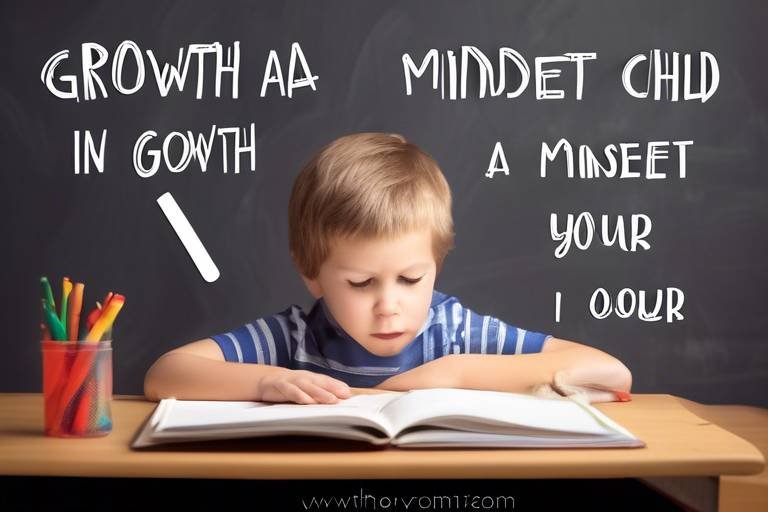Creating A Growth Mindset In Your Child
In today's fast-paced world, fostering a growth mindset in children is more important than ever. But what does that really mean? A growth mindset is the belief that abilities and intelligence can be developed through dedication and hard work. This contrasts sharply with a fixed mindset, where individuals believe their talents are static and unchangeable. By instilling this belief in children, we can equip them with the tools they need to navigate life's challenges, embrace learning opportunities, and ultimately thrive in various aspects of their lives.
Understanding the concept of a growth mindset is crucial for parents and educators alike. When children believe that their abilities can improve, they are more likely to take risks and engage deeply with their learning. This mindset encourages them to see failures not as roadblocks but as stepping stones toward greater understanding and skill. Imagine a world where children approach problems with curiosity rather than fear—this is the essence of a growth mindset.
So, why should we care about fostering a growth mindset in our kids? The benefits are numerous and impactful, leading to long-term advantages that can shape their futures. Children who embrace a growth mindset tend to be more motivated, perform better academically, and develop enhanced emotional resilience. They learn to appreciate the journey of learning itself, rather than just focusing on the end results.
Research shows that children with a growth mindset are more likely to embrace challenges and persist in the face of setbacks. This resilience is key to their academic success. When they encounter difficulties, instead of throwing in the towel, they double down and seek solutions. This persistence leads to improved learning outcomes over time, as they develop a deeper understanding of the material.
One effective way to nurture a growth mindset is to focus on effort rather than innate talent. When children understand that hard work and perseverance are the true keys to success, they begin to cultivate a love for learning. This shift in focus helps them explore new concepts and tackle challenges head-on, knowing that their efforts will pay off in the long run.
Encouraging children to tackle difficult tasks is another vital aspect of fostering a growth mindset. When they face challenges, they build confidence and resilience. Instead of viewing obstacles as something to avoid, they learn to see them as opportunities for growth. This perspective shift can be transformative, empowering them to take on new experiences with enthusiasm.
A growth mindset also equips children with the emotional tools they need to cope with failures and setbacks. Life is full of ups and downs, and how children respond to these challenges can shape their overall well-being. By teaching them to approach failures as learning experiences, we promote emotional strength and healthier responses to life's inevitable challenges.
Now that we understand the importance of a growth mindset, let's explore some strategies that parents and educators can implement to nurture this outlook in children.
One effective strategy is to recognize and reward hard work and persistence rather than innate ability. When children receive praise for their efforts, they learn that success comes from dedication. This reinforces the value of effort and encourages them to embrace challenges wholeheartedly.
Adults play a crucial role in demonstrating a growth mindset through their own actions and attitudes. By sharing personal experiences of perseverance, learning from mistakes, and striving for self-improvement, we provide children with real-life examples of how a growth mindset can lead to success.
Q: What age should I start teaching my child about growth mindset?
A: It's never too early! Children as young as preschool age can begin to understand the basic concepts of effort and learning. The earlier you start, the more ingrained these ideas will become.
Q: How can I tell if my child has a fixed mindset?
A: Look for signs such as avoiding challenges, giving up easily, or feeling threatened by the success of others. These may indicate a fixed mindset that needs nurturing towards growth.
Q: Can a growth mindset be developed in adults too?
A: Absolutely! While this article focuses on children, the principles of a growth mindset apply to individuals of all ages. Adults can benefit from adopting a growth mindset in personal and professional settings.
Q: What are some books I can read to learn more about growth mindset?
A: A great starting point is "Mindset: The New Psychology of Success" by Carol S. Dweck, who coined the terms "growth mindset" and "fixed mindset." There are also many children's books that illustrate these concepts in relatable ways.

Understanding Growth Mindset
A growth mindset is more than just a buzzword; it’s a powerful concept that can transform the way children approach learning and challenges. At its core, a growth mindset is the belief that abilities and intelligence can be developed through dedication, hard work, and perseverance. This idea stands in stark contrast to a fixed mindset, where individuals believe their talents and intelligence are static traits that cannot change. Imagine a world where children see their potential as a garden that can flourish with the right care and nurturing, rather than a fixed stone that can’t be shaped or altered.
Understanding the significance of a growth mindset is crucial for both parents and educators. When children embrace this mindset, they become more resilient and adaptable, allowing them to tackle obstacles head-on. They learn to view failures not as dead ends but as stepping stones toward growth. For instance, when a child struggles with a math problem, instead of feeling defeated, they might think, “What can I learn from this experience?” This shift in perspective can lead to a more fulfilling learning journey.
To illustrate the differences between a growth mindset and a fixed mindset, consider the following table:
| Growth Mindset | Fixed Mindset |
|---|---|
| Believes abilities can be developed | Believes abilities are fixed traits |
| Embraces challenges | Avoids challenges |
| Persists in the face of setbacks | Gives up easily |
| Sees effort as a path to mastery | Views effort as fruitless |
| Learn from criticism | Ignores feedback |
By fostering a growth mindset, children can develop an intrinsic motivation to learn, allowing them to thrive not only academically but also socially and emotionally. This mindset encourages them to ask questions, seek help, and engage in discussions, which are vital skills in today’s world. So, how do we instill this mindset in our children? It starts with understanding the principles behind it and recognizing the signs of a fixed mindset when they arise. With the right guidance, we can help our children cultivate a love for learning that lasts a lifetime.

Benefits of a Growth Mindset
When we talk about the , we're diving into a treasure trove of advantages that can significantly impact a child's life. Imagine a child who sees challenges not as roadblocks but as exciting puzzles to solve. This shift in perspective can lead to profound changes in their motivation and overall performance. One of the most remarkable benefits is the increase in motivation. Children who believe that their abilities can improve through effort are more likely to tackle difficult tasks with enthusiasm. They don’t shy away from challenges; instead, they embrace them, knowing that each hurdle they overcome is a step towards becoming stronger and smarter.
Moreover, a growth mindset enhances academic performance. Studies have shown that children who adopt this mindset tend to achieve better grades. They are more resilient in the face of setbacks and are less likely to give up when the going gets tough. For instance, when faced with a challenging math problem, a child with a growth mindset is likely to persist, try different strategies, and ultimately find a solution, while a child with a fixed mindset might simply throw in the towel after a few failed attempts.
Another significant advantage is the development of emotional resilience. Life is full of ups and downs, and children with a growth mindset are better equipped to handle failures. Instead of viewing setbacks as a reflection of their abilities, they see them as opportunities to learn and grow. This perspective not only helps them bounce back quicker but also fosters a healthier emotional response to life's inevitable challenges. They learn that it's okay to fail, as long as they learn something from it. This resilience is crucial in today’s fast-paced world, where adaptability is key.
In addition to these benefits, children with a growth mindset often develop a lifelong love for learning. They become curious explorers, eager to acquire new knowledge and skills. This intrinsic motivation can lead to a more fulfilling educational experience and a greater likelihood of pursuing higher education and career opportunities. When children are encouraged to embrace the process of learning rather than just focusing on the end results, they cultivate a genuine interest in discovering the world around them.
To summarize, the benefits of fostering a growth mindset in children are far-reaching and can be life-changing. They include:
- Increased motivation to tackle challenges
- Improved academic performance through persistence and resilience
- Enhanced emotional resilience to cope with failures
- Lifelong love for learning that fosters curiosity and exploration
In the long run, instilling a growth mindset in children not only prepares them for academic success but also equips them with essential life skills that will serve them well into adulthood. They learn to approach life with a sense of adventure, ready to take on whatever comes their way.
Q: What is a growth mindset?
A: A growth mindset is the belief that abilities and intelligence can be developed through dedication and hard work, leading to a love for learning and resilience in the face of challenges.
Q: How can I encourage a growth mindset in my child?
A: You can encourage a growth mindset by praising their effort instead of their intelligence, modeling resilience in your own life, and encouraging them to embrace challenges as opportunities for growth.
Q: What are the long-term benefits of a growth mindset?
A: Long-term benefits include improved academic performance, greater emotional resilience, and a lifelong love for learning, which can lead to better career opportunities and personal fulfillment.

Improved Academic Performance
This article explores how to foster a growth mindset in children, emphasizing the importance of resilience, adaptability, and a love for learning to help them thrive in various aspects of life.
A growth mindset is the belief that abilities and intelligence can be developed through dedication and hard work. This section explains its significance and how it contrasts with a fixed mindset.
Cultivating a growth mindset in children can lead to increased motivation, better academic performance, and improved emotional resilience. Here, we discuss the long-term advantages of embracing this approach.
Children with a growth mindset are more likely to embrace challenges and persist in the face of setbacks, leading to enhanced learning outcomes and academic success over time. Imagine a child tackling a math problem that seems insurmountable. Instead of throwing in the towel, a child with a growth mindset sees it as a puzzle to solve rather than a brick wall. This perspective shift is crucial; it transforms frustration into motivation.
Research indicates that students who adopt a growth mindset tend to achieve higher grades and perform better on standardized tests. They are not just memorizing facts; they are engaging with the material, asking questions, and seeking deeper understanding. When faced with difficulties, these children are more likely to utilize effective strategies, such as:
- Seeking help from teachers or peers
- Using resources like textbooks and online tutorials
- Practicing regularly to master challenging concepts
This proactive approach to learning fosters a sense of ownership over their education. They begin to realize that their efforts directly correlate with their success, which can be incredibly empowering. Think of it as planting seeds in a garden; the more you water and nurture them, the more they grow. In the classroom, this translates to a willingness to take risks, which is often a precursor to significant academic breakthroughs.
Focusing on effort rather than innate talent helps children understand that perseverance is key to success, fostering a love for learning and exploration of new concepts. When children hear phrases like, “I’m proud of how hard you worked on that project,” they learn to value the process over the product. This also helps them to develop a healthier relationship with failure. Instead of seeing it as a dead end, they view it as a stepping stone to improvement.
Encouraging children to tackle difficult tasks builds their confidence and resilience, helping them view challenges as opportunities for growth rather than obstacles to avoid. Whether it’s a tough science project or a challenging piece of literature, facing these hurdles head-on can lead to remarkable learning experiences. Just like athletes train harder to improve their performance, children can learn that every challenge is a chance to strengthen their skills.
A growth mindset equips children with the tools to cope with failures and setbacks, promoting emotional strength and a healthier response to life's challenges.
Parents and educators can implement various strategies to nurture a growth mindset in children, including praise for effort, modeling resilience, and encouraging risk-taking in learning.
Recognizing and rewarding hard work and persistence rather than innate ability reinforces the value of effort and encourages children to embrace challenges.
Adults can demonstrate a growth mindset through their own actions and attitudes, providing children with real-life examples of perseverance, learning from mistakes, and ongoing self-improvement.
1. What is a growth mindset?
A growth mindset is the belief that abilities and intelligence can be developed through dedication and hard work.
2. How can I help my child develop a growth mindset?
Encourage effort over results, embrace challenges, and model resilience in your own life.
3. What are the benefits of a growth mindset?
Benefits include improved academic performance, increased motivation, and enhanced emotional resilience.
4. Can a growth mindset be taught?
Yes, through consistent encouragement and positive reinforcement, children can learn to adopt a growth mindset.

Encouraging Effort Over Results
In the journey of nurturing a growth mindset in children, one of the most powerful tools at our disposal is the emphasis on effort rather than merely the outcomes. When we shift our focus from the end results to the hard work and dedication put into achieving those results, we create an environment where children feel valued for their persistence and resilience. Think about it: when a child receives praise solely for winning a race or acing a test, they may feel pressure to always perform at that level. However, if we celebrate their effort—like training hard for that race or studying diligently for that test—they learn that the process is just as important, if not more so, than the final score.
This approach not only reinforces the idea that success is attainable through hard work, but it also helps children develop a love for learning. By recognizing their effort, we encourage them to take on new challenges without the fear of failure looming over them. For instance, instead of saying, “You’re so smart!” when they solve a difficult math problem, we can say, “I’m really proud of how hard you worked to figure that out!” This simple change in language sends a strong message: effort is what leads to improvement and success.
Moreover, when children see that effort is valued, they become more willing to engage in activities that might initially seem daunting. They start to understand that every setback is an opportunity to learn and grow. For example, if a child struggles with learning a musical instrument, praising their practice sessions rather than their performance can motivate them to keep trying, ultimately leading to greater mastery over time. This mindset cultivates a sense of adventure and curiosity, allowing them to explore their interests freely.
To further illustrate the importance of encouraging effort, consider the following examples of how this can be applied in everyday situations:
- Homework Completion: Instead of only acknowledging the grade on an assignment, discuss the strategies they used to tackle difficult questions.
- Sports Participation: Celebrate the hours of practice they put in rather than just the trophies they win.
- Creative Projects: Focus on the creative process and the hard work invested in a project, regardless of the final product.
Ultimately, by fostering an environment where effort is celebrated, we empower children to embrace challenges and develop a lifelong love for learning. This shift in focus not only builds their self-esteem but also equips them with the resilience needed to navigate the ups and downs of life. As they grow, they will carry this understanding with them, applying it in various aspects of their lives—academically, socially, and personally. In a world that often prioritizes quick results, let’s encourage our children to appreciate the journey, because that’s where the real growth happens.
Q: What is the best way to praise my child’s efforts?
A: Focus on specific actions they took, such as saying, “I really admire how much time you spent practicing your speech. It really showed in your delivery!”
Q: How can I help my child when they feel discouraged?
A: Remind them of past challenges they overcame through effort, and encourage them to view setbacks as learning opportunities rather than failures.
Q: Can a growth mindset be developed in older children?
A: Absolutely! It’s never too late to encourage a growth mindset. Start by discussing the importance of effort and resilience, and model these behaviors in your own life.

Embracing Challenges
Embracing challenges is like stepping into a world filled with opportunities for growth and self-discovery. When children are encouraged to tackle difficult tasks, they not only build their confidence but also develop resilience that will serve them throughout their lives. Imagine a young child facing a math problem that seems impossible at first glance. Instead of shying away from it, they are encouraged to dive in, explore different strategies, and even make mistakes along the way. This process is invaluable.
When children view challenges as opportunities rather than obstacles, they cultivate a sense of curiosity and a desire to learn. For instance, consider the analogy of a seed planted in rocky soil. The seed must push through the tough ground to reach the sunlight. Similarly, children who embrace challenges must push through discomfort and uncertainty to achieve their goals. This struggle is not just about overcoming the immediate hurdle; it's about developing a mindset that seeks growth in every experience.
Here are some key points to consider when encouraging children to embrace challenges:
- Normalize Failure: Teach children that failure is not the end but a stepping stone to success. Share stories of famous personalities who faced setbacks but ultimately triumphed.
- Encourage Problem-Solving: Instead of providing immediate solutions, guide children to think critically and come up with their own strategies for overcoming obstacles.
- Celebrate Effort: Acknowledge the hard work they put into facing challenges, regardless of the outcome. This reinforces the idea that effort is what truly matters.
By fostering an environment where challenges are welcomed, parents and educators can help children develop a robust toolkit for life. They learn to approach new situations with a sense of adventure rather than fear. This shift in perspective can lead to a lifelong love of learning and a willingness to tackle even the most daunting tasks.
Ultimately, embracing challenges is not just about achieving success; it's about the journey of growth that comes along with it. When children learn to see challenges as opportunities, they are better equipped to navigate the complexities of life, making them more adaptable and resilient individuals. So, let's encourage our children to take that leap of faith, tackle tough problems, and find joy in the process of overcoming challenges!
Q: How can I help my child embrace challenges?
A: Start by fostering a positive attitude towards challenges. Encourage them to try new things, provide support when they face difficulties, and celebrate their efforts regardless of the outcome.
Q: What if my child is afraid of failing?
A: Normalize failure by sharing stories of successful individuals who faced setbacks. Teach them that failure is a part of the learning process and an opportunity to grow.
Q: Are there specific activities that promote a growth mindset?
A: Yes! Activities such as puzzles, team sports, or even creative projects can help children learn to embrace challenges and develop problem-solving skills.

Enhanced Emotional Resilience
Building a growth mindset in children is like giving them a sturdy umbrella on a rainy day. It equips them with the tools they need to navigate life's storms, helping them bounce back from setbacks with a sense of strength and determination. When children understand that failures are not the end of the world but rather stepping stones toward success, they develop a profound sense of emotional resilience. This resilience is crucial; it allows them to face challenges head-on rather than shy away from them.
Imagine a child who encounters a difficult math problem. With a growth mindset, instead of feeling defeated, they see it as an opportunity to learn. They might think, "I can figure this out if I try different strategies." This shift in perspective is powerful—it transforms challenges into learning experiences. By fostering this mindset, parents and educators can help children cultivate a healthier relationship with failure. They learn that it’s okay to stumble; what matters is how they get back up.
Moreover, emotional resilience doesn't just benefit children in academic settings. It spills over into their personal lives, helping them manage friendships, family dynamics, and even future workplace challenges. When children learn to embrace setbacks, they become more adaptable, able to handle changes and uncertainties with grace. This adaptability is a vital skill in today's fast-paced world, where change is the only constant.
To illustrate the impact of a growth mindset on emotional resilience, consider the following table:
| Scenario | Fixed Mindset Reaction | Growth Mindset Reaction |
|---|---|---|
| Receiving a poor grade | “I’m just not good at this subject.” | “I need to study differently and ask for help.” |
| Struggling with a new skill | “I’ll never be able to do this.” | “I can improve with practice and patience.” |
| Facing rejection | “I must not be good enough.” | “This is a chance to learn and grow.” |
This table highlights how a growth mindset can dramatically alter a child's reaction to various challenges, promoting a more positive and proactive approach to life's hurdles. As parents and educators, it's essential to guide children in recognizing that emotional resilience is built through experience and reflection. Encourage them to talk about their feelings when they face difficulties. Ask questions like, "What did you learn from this experience?" or "How can you approach it differently next time?" These conversations not only reinforce their ability to cope but also strengthen their emotional intelligence.
In conclusion, fostering emotional resilience through a growth mindset is a gift that keeps on giving. It prepares children not just for academic success but for a fulfilling life where they can navigate the ups and downs with confidence and optimism. So, let’s equip our children with that sturdy umbrella, ensuring they can weather any storm that comes their way!
- What is a growth mindset? A growth mindset is the belief that abilities and intelligence can be developed through dedication and hard work.
- How can I help my child develop a growth mindset? Encourage them to embrace challenges, praise their effort, and model resilience in your own actions.
- What are the benefits of a growth mindset for children? It leads to improved academic performance, enhanced emotional resilience, and a lifelong love for learning.

Strategies to Foster a Growth Mindset
Fostering a growth mindset in children is not just about telling them to "try harder" or "never give up." It's about creating an environment where they feel safe to explore, take risks, and learn from their experiences. This journey begins at home and in educational settings, where both parents and educators play pivotal roles. Here are some effective strategies to help nurture this invaluable mindset in your child.
One of the most powerful approaches is praising effort rather than intelligence. When children are recognized for their hard work and persistence, they learn that effort is what leads to success. Instead of saying, "You're so smart," try saying, "I’m so proud of how hard you worked on that project!" This subtle shift in language can significantly impact how children perceive challenges. They start to understand that struggles are part of the learning process, making them more likely to embrace difficult tasks.
Another crucial strategy is modeling a growth mindset in your own life. Children are like sponges; they absorb not only what you say but also what you do. Share your own experiences of overcoming obstacles and learning from failures. For instance, if you faced a challenge at work, discuss how you approached it, what you learned, and how you improved. This not only provides them with a real-life example but also shows them that everyone faces challenges, and it's okay to stumble along the way.
Encouraging risk-taking in learning is also essential. Create an atmosphere where trying new things is celebrated, even if they don’t always succeed. For example, if your child wants to try a new sport or instrument, support them wholeheartedly, emphasizing that the experience itself is valuable, regardless of the outcome. This teaches them that the journey of learning is just as important as the destination.
Additionally, you can incorporate goal-setting into their routine. Help your child set realistic, achievable goals and break them down into smaller steps. Celebrate each milestone they reach, no matter how small, which reinforces the idea that progress is a continuous journey. This practice not only boosts their confidence but also instills a sense of responsibility for their own growth.
Lastly, encourage open discussions about mistakes and failures. Instead of shying away from these topics, use them as teaching moments. Ask your child what they learned from a mistake or how they might approach a similar situation differently next time. This not only helps them process their experiences but also reinforces the notion that failure is not the end but rather a stepping stone to success.
In conclusion, fostering a growth mindset in children requires a combination of praise, modeling, encouragement, and open dialogue. By implementing these strategies, you can help your child develop resilience, adaptability, and a lifelong love for learning. Remember, it’s not just about the destination; it’s about the journey of growth and discovery.
- What is a growth mindset? A growth mindset is the belief that abilities and intelligence can be developed through dedication and hard work.
- How can I tell if my child has a fixed mindset? Signs include avoiding challenges, giving up easily, and feeling threatened by the success of others.
- What are some activities to promote a growth mindset? Encourage activities that involve problem-solving, creativity, and teamwork, such as group projects or creative arts.
- How important is praise in fostering a growth mindset? Praise is crucial; however, it should focus on effort and improvement rather than innate abilities.

Praising Effort, Not Intelligence
When it comes to nurturing a child's growth mindset, one of the most powerful tools in your arsenal is the way you offer praise. Instead of showering your child with compliments about their intelligence, try focusing on their effort. This shift in perspective can have profound effects on their approach to learning and challenges. Think about it: when you tell a child they're "smart," you're placing a label on them that can create pressure to maintain that image. On the other hand, praising effort sends a message that hard work, determination, and resilience are what truly matter.
Imagine a scenario where your child struggles with a math problem. If you praise them for being "smart," they may feel discouraged when they encounter a tougher problem later on. They might think, "If I can't solve this, maybe I'm not smart after all." However, if you commend their effort—saying something like, "I really admire how hard you worked on that problem!"—you're reinforcing the idea that persistence is key. This encourages them to tackle future challenges with a mindset geared toward growth and learning.
To make this concept more tangible, consider these practical examples of how to praise effort:
- Instead of saying, "You're so smart!" you might say, "I can see how much effort you put into that project!"
- When your child faces a setback, instead of saying, "You should have done better," try, "What strategies can we use next time to improve?"
- Encourage them by acknowledging their progress, such as, "Look how much you've improved since you started practicing!"
Praising effort not only enhances a child's self-esteem but also fosters a love for learning. They begin to associate challenges with growth rather than fear of failure. This approach cultivates resilience, as they learn that it's okay to stumble along the way; what matters is getting back up and trying again. Over time, this mindset can lead to a more fulfilling educational experience, where children feel empowered to explore, experiment, and ultimately thrive.
In conclusion, shifting the focus of praise from intelligence to effort is a simple yet transformative strategy for parents and educators alike. By doing so, we can help children develop a robust growth mindset that prepares them for life's many challenges. Remember, it's not about being smart; it's about being willing to work hard, learn, and grow.
- What is a growth mindset? A growth mindset is the belief that abilities and intelligence can be developed through dedication and hard work.
- How can I encourage a growth mindset in my child? Focus on praising their efforts, encourage them to embrace challenges, and model resilience in your own life.
- Why is praising effort important? Praising effort fosters resilience and a love for learning, helping children to view challenges as opportunities for growth.

Modeling a Growth Mindset
Modeling a growth mindset is one of the most powerful ways to instill this valuable perspective in your child. As parents and educators, our actions speak volumes. Children are like sponges, soaking up our behaviors, attitudes, and reactions. When we demonstrate a growth mindset in our daily lives, we provide them with a living example of how to approach challenges, learn from mistakes, and continuously strive for improvement. But how exactly can we model this mindset?
One effective way is to openly discuss our own struggles and the lessons learned from them. For instance, if you encounter a problem at work, share your thought process with your child. Explain how you tackled the issue, the mistakes you made, and how you adjusted your approach. This transparency not only normalizes failure but also shows that perseverance is key. It's not about being perfect; it's about being willing to grow.
Additionally, we can create an environment that celebrates effort and learning. For example, when your child tries something new, whether it’s a sport, an instrument, or a school project, emphasize the effort they put in rather than focusing solely on the outcome. You might say, “I’m so proud of how hard you worked on that project!” This reinforces the idea that hard work is valued and that success is a journey rather than a destination.
Another important aspect is to embrace challenges ourselves. When faced with a difficult task, instead of shying away, we should approach it with enthusiasm and a can-do attitude. This might mean picking up a new hobby, tackling a complex recipe, or learning a new skill. By showing our children that we are willing to step out of our comfort zones, we encourage them to do the same. Remember, kids learn best by observing us!
To further illustrate this point, let’s look at a simple table that highlights key actions we can take to model a growth mindset:
| Action | Description |
|---|---|
| Share Experiences | Discuss your own challenges and how you overcame them. |
| Celebrate Effort | Focus on the hard work your child puts in, not just the results. |
| Embrace Challenges | Take on new tasks and show enthusiasm for learning. |
| Encourage Reflection | Help your child reflect on their experiences and what they learned. |
Lastly, it's crucial to encourage reflection on both successes and failures. After completing a task, ask your child what they learned from the experience, regardless of the outcome. This not only helps them to internalize the lessons learned but also reinforces that every experience is an opportunity for growth. By actively modeling a growth mindset, we empower our children to embrace their own learning journeys with confidence and resilience.
- What is a growth mindset? A growth mindset is the belief that abilities and intelligence can be developed through dedication and hard work.
- How can I encourage a growth mindset in my child? You can encourage a growth mindset by praising effort, modeling resilience, and creating an environment that embraces challenges.
- What are the benefits of having a growth mindset? Benefits include improved academic performance, enhanced emotional resilience, and a greater love for learning.
Frequently Asked Questions
- What is a growth mindset?
A growth mindset is the belief that abilities and intelligence can be developed through dedication and hard work. It emphasizes the importance of resilience, adaptability, and a love for learning, contrasting sharply with a fixed mindset, where individuals believe their abilities are static and unchangeable.
- How can a growth mindset benefit my child?
Embracing a growth mindset can lead to increased motivation, better academic performance, and enhanced emotional resilience. Children who adopt this mindset are more likely to face challenges head-on, persist through difficulties, and view setbacks as opportunities for growth.
- What are some strategies to foster a growth mindset in children?
Parents and educators can nurture a growth mindset by praising effort rather than intelligence, modeling resilience in their own lives, encouraging children to take risks in learning, and helping them understand that mistakes are valuable learning opportunities.
- How does praising effort over intelligence help?
Praising effort reinforces the idea that hard work and perseverance are key to success. This approach encourages children to embrace challenges and understand that improvement comes from dedication and practice, rather than just innate talent.
- Can a growth mindset be taught?
Absolutely! A growth mindset can be cultivated through intentional teaching and encouragement. By providing children with examples, positive reinforcement, and opportunities to face challenges, adults can help instill this valuable mindset.
- What role do setbacks play in developing a growth mindset?
Setbacks are essential in developing a growth mindset. They provide opportunities for children to learn resilience and adaptability. Instead of fearing failure, children learn to view it as a stepping stone to success and a chance to grow.
- How can I model a growth mindset for my child?
You can model a growth mindset by sharing your own experiences of perseverance, discussing your mistakes and what you've learned from them, and demonstrating a willingness to tackle challenges. Your attitude towards learning and growth will significantly influence your child's perspective.



















